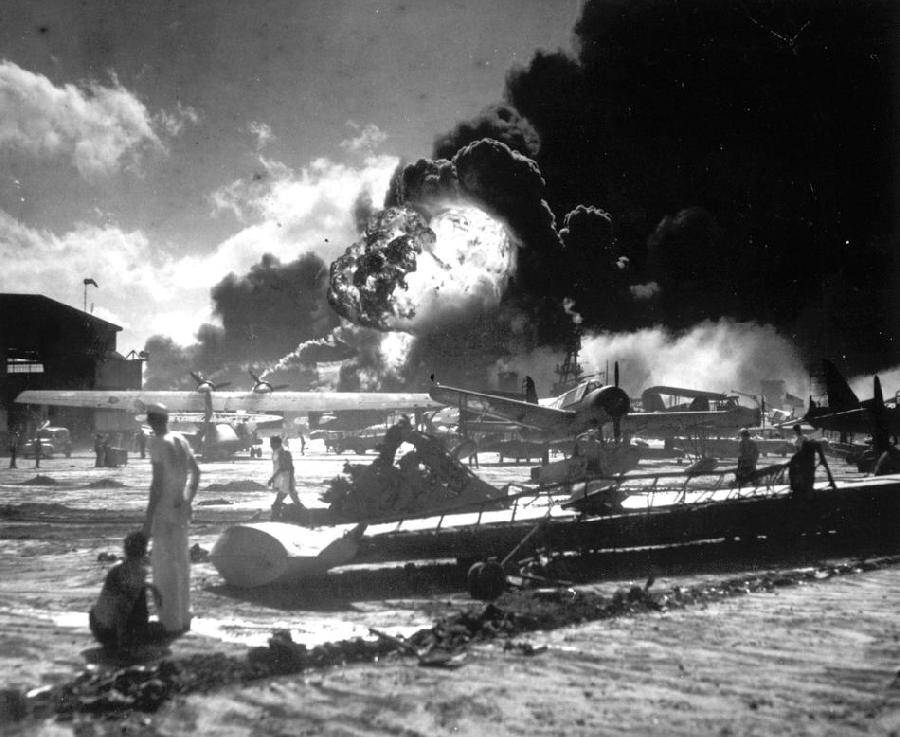
World War II Strategy: The Pacific War

Figure 1.--After Hitler launched World War II by invading Poland (September 1939), the militarists controlling Japan, already involved in a protracted war un China, began planning out they could beneft. After more than 2 years of detailed planning and assessment, their war strategy was to attack the United States. Pearl Harbor was a stunning victory it was also the most disatrous war strategy ever executed in the history of warfare. Historians with the benefits of hindsight find it difficult to understand how the Japanese could have conceived of such a strategy. Some Japanese historians claim that Japan was 'tricked'. In fairness to the Japanese war planners, 3 days after the attack on Pearl, the Red Army laumched an offensive in front of Moscow that inflicted such casualties on the Wehrmacht that NAZI Germany could no longer win the War. Part of Japan's calculation was that Germany would defeat the Soviets and force the Americans And British to concentrate their resources in Europe. Ironically, this is what American and Britain did. Source: Wire service press photo.
|
|
Japan had a very different strategic concept than the Germans. Japan had no interest in a commerce war, although given the vulnerability of Pacific sea lanes this would have been a potentially useful strategy. Japan unlike Germany did have a poerful surface fleet. The Imperiall Navy's strategic doctrine was to destroy the eneny in a climatic naval battle. Japan had been fighting a war in China for several years. America was increasing its diplomatic and material support for China, much to the outrage of the Japanese militarists. Japan joined the Axis (1940) to discourage the Americans. The impact was the exact opposite. Japanese expansion in China and Indochina (Vietnam) prompted increasingly severe American steps leading to a potentially crippling oil embargo. The result was that the Japanese who had been considering striking north against the Soviet Union decided on striking south and war with America and Britain. This meant a naval war aimed at securing the oil and others resources of Southeast Asia needed to fight a war. Like the Germans, the Japanse were gambling that they could gain crippling early victories before America could mobilize and bring its enormous industrial strength to bear. And to achieve this, the Japanese ammassed a powerful carrier force which unbeknownst to the United States was superbly trained and equipped. American naval docrtrine was also to seek out the eneny in a climatic naval battle. The damage sustained by the Pacific Fleet at Pearl Harbor was severe, but not fatal. But, it forced the United States to adjust its strategy. Given the power of the Imperial fleet at the start of the War, the Japanese attack probably saved thousands of lives. Many more sailors would have perished if the battleships had been sunk at sea. The American strategy became to first use its carriers to stage hit and run attacks and tghen taken on the Japanese carriers, first in the Coral Sea and then at Midway. Sucess enabled the Pacific Fleet to slug it out in around the Solomons. The result was that the Imperial Fleet withdrew from the South Pacific. The United States unlike the Imperial Fleet, launched a coomerce war which eventiually cut the Japanese Home Islands off from their resource-rich conquests--the Souuthern Resource Zone they went to war for in the first place. This enabled the United States to pursue its central strategy, build ships, ships, and more ships. Not only did the United States had a vastly superior capacity to build ships, but it built even more shipyards. And the Japanes despite their stunning comquests had no way of impeding American war production. Amazingly it was not even part of their strategy. The result was that when the climatic naval battles came, the Pacific Fleet out numbered the Japanese in every class of vessel and the increasing number of carriers carried modern new aircradt with outclassed the Japanese who were still using the aircraft they used to launch the War. The climatic naval battle the two fleets sought would finally come at Leyte Gulf. It proved to be cthe greatest battle in naval warfare. By this time the Japanese carrier fleet had been crippled and the Japanese merchant marine virtually destroyed.
HBC

Navigate the Boys' Historical Clothing Web Site:
[Return to Main World War II naval strategy page]
[Return to Main World War II naval campaign page]
[Return to Main World War II page]
[Introduction]
[Activities]
[Biographies]
[Chronology]
[Clothing styles]
[Countries]
[Bibliographies]
[Contributions]
[FAQs]
[Glossaries]
[Images]
[Links]
[Registration]
[Tools]
[Boys' Clothing Home]
Created: 12:08 AM 8/9/2010
Last updated: 12:08 AM 8/9/2010



